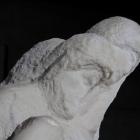Michelangelo’s final artistic expression, the Rondanini Pieta, uses a novel approach in relation to the model adopted in his early sculptures to portray a moving and intense deposition of the dead Christ, who is held upright by his mother before his burial. A sheet with five pencil sketches by Michelangelo, held in the Ashmolean Museum in Oxford (inv. WA1846.85), documents the study of and interest in this theme, which was so dear to him.
From the sketchy information available on the last Pietà, it has been hypothesized that Michelangelo began carving the marble between 1553 and 1555. In Ascanio Condivi’s 1553 biography of the artist the Pietà is not mentioned, while in 1555 Vasari says that Michelangelo, after having reduced to fragments the Pietà Bandini, started to chisel on a piece of marble that had "already taken the shape of another distinct and much smaller Pietà”, today identified by scholars as the Rondanini Pietà.
Revision and modification
The artist in the last decade of his life worked on this sculptural group several times, continuously rethinking and changing his approach during the work. He changed the proportions of Christ’s body, emaciating the torso and legs and lowering and thinning the head, which is thought to initially have been higher and closer to that of the Madonna, who is to the right from the perspective of the viewer and whose gaze diverges from that of the Son. Michelangelo also changed Christ’s arms, so they are leaning upon and fused with the body of the mother.
All that remains of the first version of the Pietà are Christ’s right arm, broken at the elbow and which the artist most probably would have removed at a later stage, the legs which he had already begun to make thinner and the back part of the Virgin, which Michelangelo had not managed to thin down so as to balance the entire composition before his death.
Sculpting to the very end
Two letters written by Michelangelo’s pupil Daniele da Volterra in the months following the artist’s passing and addressed to his nephew, Leonardo Buonarroti and to Giorgio Vasari tell that up to just days before the artist’s death at the age of eighty-nine he continued to tirelessly chisel the work, solely for himself and intended it to be his testament.








